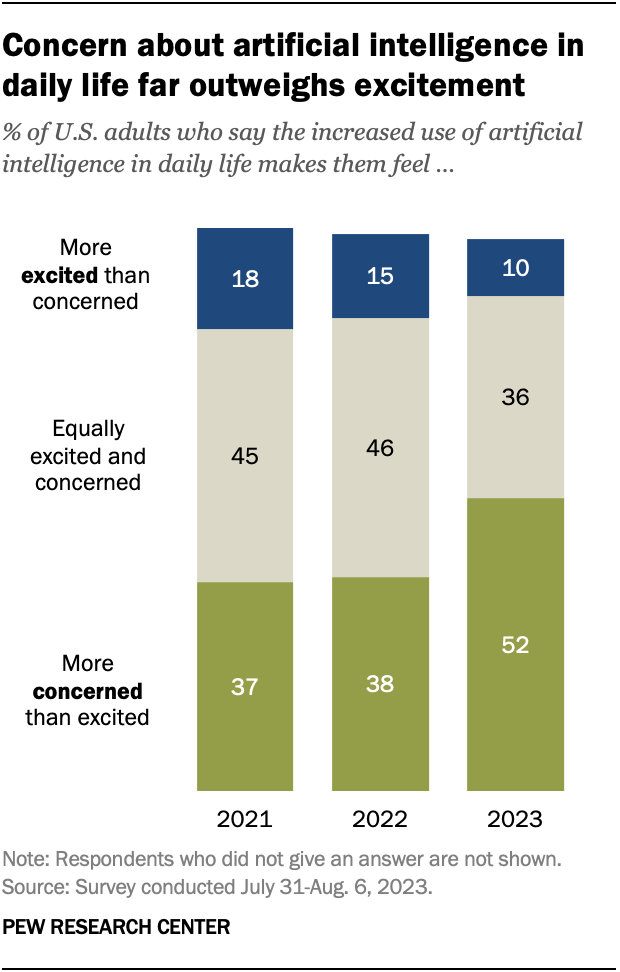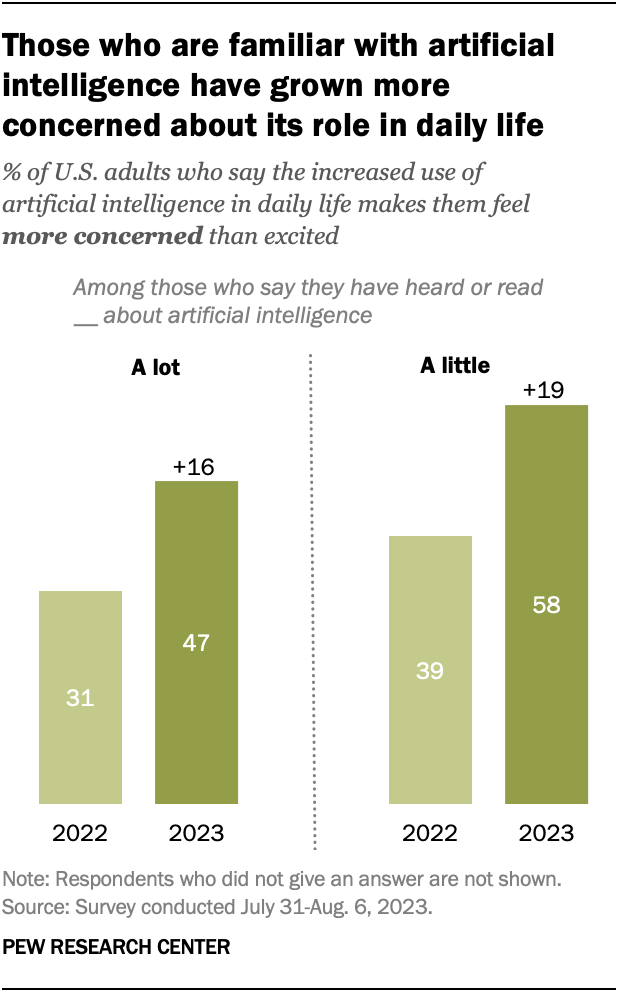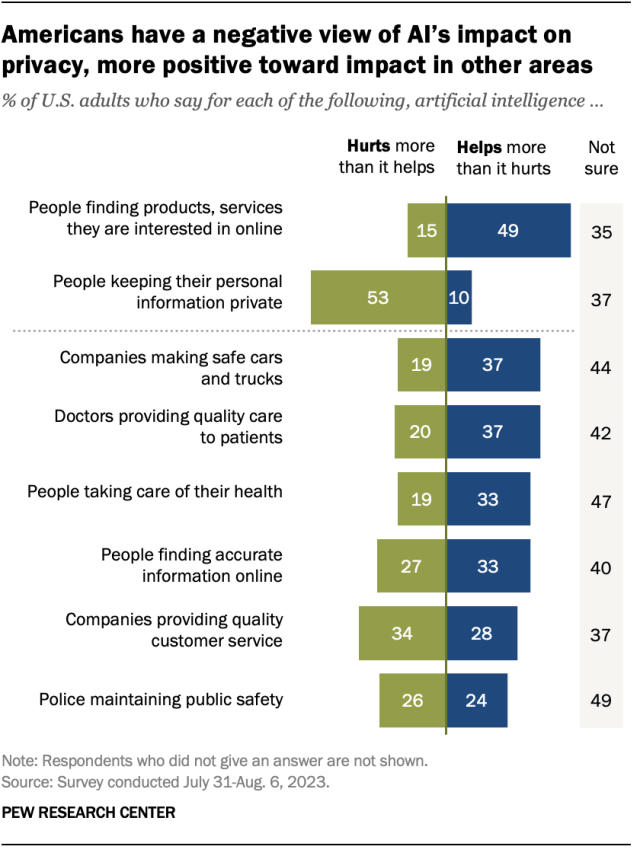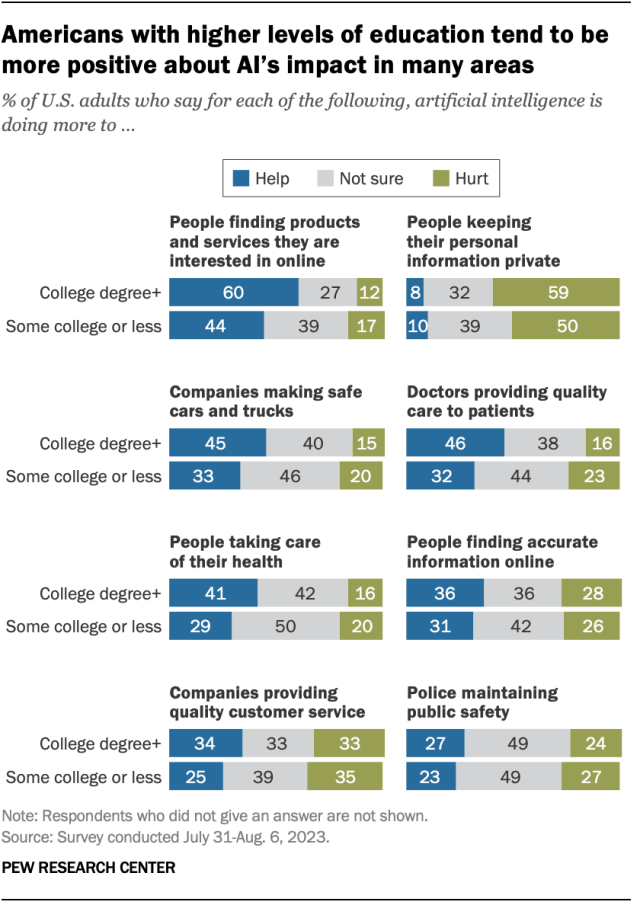A growing share of Americans express concern about the role artificial intelligence (AI) is playing in daily life, according to a new Pew Research Center survey.
Pew Research Center conducted this study to understand attitudes about artificial intelligence and its uses. For this analysis, we surveyed 11,201 U.S. adults from July 31 to Aug. 6, 2023.
Everyone who took part in the survey is a member of the Center’s American Trends Panel (ATP), an online survey panel that is recruited through national, random sampling of residential addresses. This way, nearly all U.S. adults have a chance of selection. The survey is weighted to be representative of the U.S. adult population by gender, race, ethnicity, partisan affiliation, education and other categories. Read more about the ATP’s methodology.
Here are the questions used for this analysis, along with responses, and its methodology.

Overall, 52% of Americans say they feel more concerned than excited about the increased use of artificial intelligence. Just 10% say they are more excited than concerned, while 36% say they feel an equal mix of these emotions.
The share of Americans who are mostly concerned about AI in daily life is up 14 percentage points since December 2022, when 38% expressed this view.
Concern about AI outweighs excitement across all major demographic groups. Still, there are some notable differences, particularly by age. About six-in-ten adults ages 65 and older (61%) are mostly concerned about the growing use of AI in daily life, while 4% are mostly excited. That gap is much smaller among those ages 18 to 29: 42% are more concerned and 17% are more excited.
Rising awareness, and concern, about AI

The rise in concern about AI has taken place alongside growing public awareness. Nine-in-ten adults have heard either a lot (33%) or a little (56%) about artificial intelligence. The share who have heard a lot about AI is up 7 points since December 2022.
Those who have heard a lot about AI are 16 points more likely now than they were in December 2022 to express greater concern than excitement about it. Among this most aware group, concern now outweighs excitement by 47% to 15%. In December, this margin was 31% to 23%.
Similarly, people who have heard a little about AI are 19 points more likely to express concern today than they were in December. A majority now express greater concern than excitement (58%) about AI’s growing role in daily life, while just 8% report the opposite feeling.
Our previous analyses have found that Americans’ concerns about AI include a desire to maintain human control over these technologies, doubts that AI will improve the way things are now, and caution over the pace of AI adoption in fields like health and medicine.
Opinions of whether AI helps or hurts in specific settings

Despite growing public concern over the use of artificial intelligence in daily life, opinions about its impact in specific areas are more mixed. There are several uses of AI where the public sees a more positive than negative impact.
For instance, 49% say AI helps more than hurts when people want to find products and services they are interested in online. Just 15% say it mostly hurts when used for this purpose, and 35% aren’t sure.
Other uses of AI where opinions tilt more positive than negative include helping companies make safe cars and trucks and helping people take care of their health.
In contrast, public views of AI’s impact on privacy are much more negative. Overall, 53% of Americans say AI is doing more to hurt than help people keep their personal information private. Only 10% say AI helps more than it hurts, and 37% aren’t sure. Our past research has found majorities of Americans express concern about online privacy generally and a lack of control over their own personal information.
Public views on AI’s impact are still developing, though. Across the eight use cases in the survey, 35% to 49% of Americans say they’re not sure what impact AI is having.
Demographic differences in views of AI’s impact

There are significant demographic differences in the perceived impact of AI in specific use cases.
Americans with higher levels of education are more likely than others to say AI is having a positive impact across most uses included in the survey. For example, 46% of college graduates say AI is doing more to help than hurt doctors in providing quality care to patients. Among adults with less education, 32% take this view.
A similar pattern exists with household income, where Americans with higher incomes tend to view AI as more helpful for completing certain tasks.
A big exception to this pattern is views of AI’s impact on privacy. About six-in-ten college graduates (59%) say that AI hurts more than it helps at keeping people’s personal information private. Half of adults with lower levels of education also hold this view.
Men also tend to view AI’s impact in specific areas more positively than women. These differences by education, income and gender are generally consistent with our previous work on artificial intelligence.
Note: Here are the questions used for this analysis, along with responses, and its methodology.
